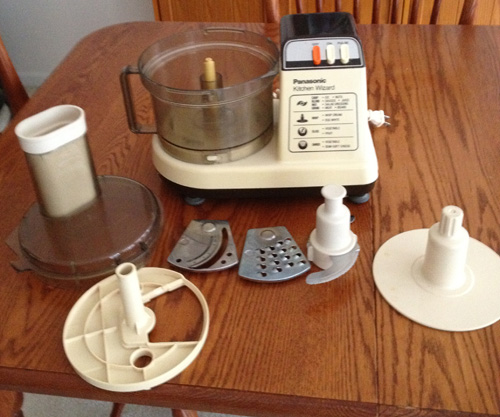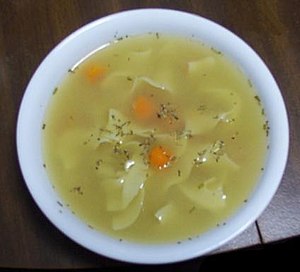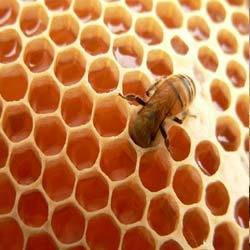
My Food Processor - Basic and Retro
A while ago I was thinking about getting a new food processor. I’d had my food processor forever and it worked well, but I kept lusting after the newer ones. Around the same time, a friend who is unemployed was also considering getting a food processor. Since I have a job, I offered my friend my old one thinking that I was in a better position to get one.
After I offered, I regretted it, but being a woman of my word, I would have gone through with it. He eventually declined and I gave a sigh of relief.
As you can see from the picture, my food processor looks nothing like the new ones which sit upright on their base and are either white or stainless steel like. Mine is beige and brown with white and orange buttons. Thinking back, I believe I got this from my sister as a wedding present for my first wedding, which was 28 years ago. This puts it in manufacture in the early 80′s. An old article from 1985 prices it at $80 which is pretty expensive for that time period. (In today’s prices, that ends up being somewhere around $168. With the exception of the china and silver and some crystal I also received as a wedding present, this is the one item I still own (and the only item I use regularly). Thanks Sis!
This food processor, has followed me through many moves, and more importantly, it still works perfectly. While not able to do many things that today’s food processors purport to do, it still does everything I need it to. From chopping down parmesan cheese for my pesto’s, beating egg whites and whipping cream as well as grating for my food preservation activities, it has been a steady partner through the years. It’s never given me a problem through all the years I’ve had it. I’ve never used it for flour, so it was something I didn’t have to discard when I found I was gluten intolerant.
I can’t say the same for many other appliances though. At last count I’ve gone through 2 food compactors and will possibly be getting my third next year. Due to moves and losing custody of items, I can’t say how many toaster ovens I’ve had, but I am currently on the second one in this house. My ex-boyfriend killed my microwave by thinking he was setting a kitchen timer (that microwave was about the same era as my food processor) and instead running the microwave on high (how he couldn’t tell the microwave was running instead of on zero power I’ll never know, but he wasn’t much on common sense). I have a microwave that runs well now, but the light element on the front is burned out and it doesn’t seem like there is any way to replace it locally. In the past 5 years I’m on my second coffee maker, and my second burr grinder. I’m also on my second Magic Bullet (a small food chopper that works great for small food amounts).
I don’t own many kitchen appliances, but I use the ones I do a lot. Since I really don’t bake, I don’t own a kitchen-aid, or a bread maker. My rule in my home is that if I buy something I must have a place to store it. (Kitchen counters are not for storing appliances in my opinion). Obviously, the toaster oven and microwave are on my counter as is my coffee maker and the grinder. Everything else has a storage place to call home when I am not actively using it.
Longevity and usefulness go hand-in-hand for me. I’m willing to spend extra money for something if the quality warrants it. Then again, my favorite cookware is cast iron. Some of my pans come from a kitchen and hardware show my parents took me to when I was 18. I still have the three cast iron frying pans from then. They are well-seasoned and while heavy, are my favorite cooking utensils. So it’s the quality that attracts me, not necessarily the price. I’m still lusting after a Le Crueset enameled dutch oven, but so far I’m just lusting, not actively pricing one out. I’ve looked at other enameled cast iron, but its the quality that draws me back.
When you purchase a quality piece for your kitchen (or have it gifted to you), cooking becomes easier. Yes, I can cook something in any pan, but a quality pan cooks more evenly as it heats, I’m less likely to burn something. Sharp, quality knives (even if I only own a few) will make chopping and cutting much easier and I’ll be less likely to hurt myself since they stay sharp longer and sharpen more easily.
So, since I know my friend reads my blog. Thank you for turning down my offer. I definitely would have followed through, but I am so glad I get to keep my work-horse. I’m hoping that my food processor and I have many more years together, turning real ingredients into wonderful meals.
UPDATE:
Since I wrote this blog post, my friend has asked take me up on my offer. Because I know he needs it and will use it well, I’m giving it to him, not with regret but with love. As you can tell from this post, my tools are loved, cared for and well used. I’ve got my eye on a Braun Food Processor, which I hope will serve me as long as my Panasonic.
Tags: Cookware, food processor, foodprocessor, Kitchen








